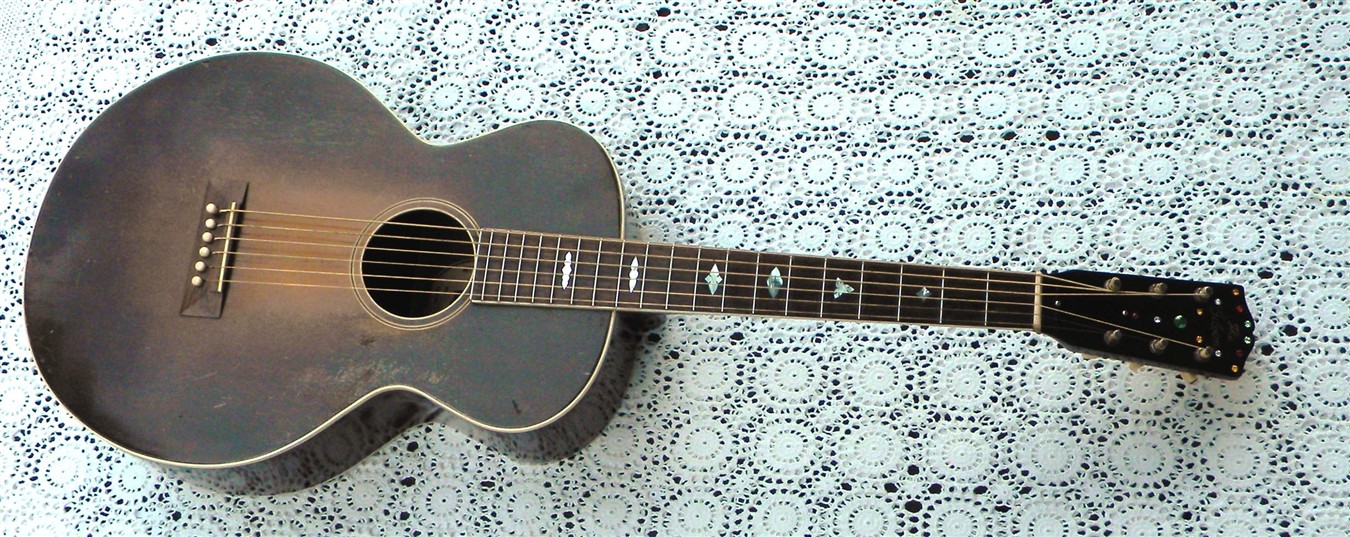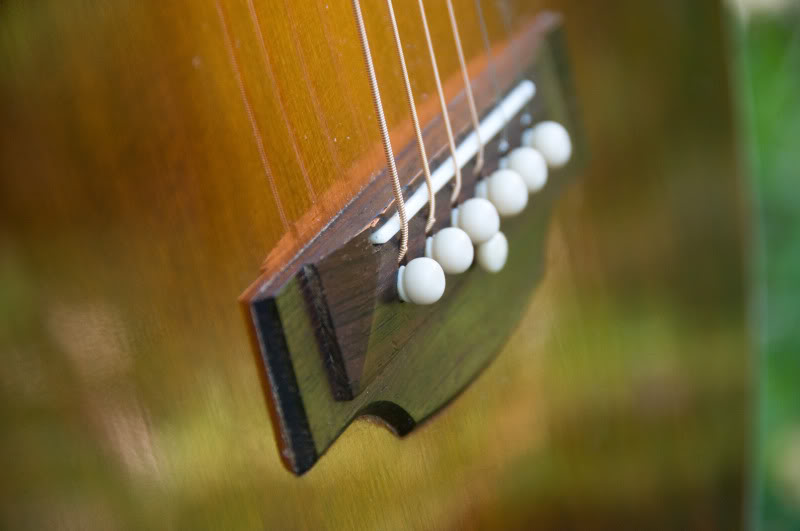I'm replacing the bridge plate on this guitar. The bridge is off. The top was bellied and it turns out the bridge plate was loose and came out with very little persuasion. I want to replace it with something a little bigger or thicker. What do you think?
Sorry I can't post pics.
Views: 3120
Replies to This Discussion
-
It's definitely not the same bridge that you see on most vintage Gibson L00, but my luthier took the bridge plate off, and saw that there is no evidence of any other type of bridge ever being on this guitar. It was re-glued at some time, but no "footprint" whatsoever of the longer thinner bridge ever being on this guitar. My luthier is confused, because he has never seen such a thing. The guitar was bought in Canada, which is probably why it has MADE IN THE U.S.A. stamped in the back of headstock. He sent me a picture of another Gibson L00 near identical (14 frets to the body, truss-rod, largest sunburst of the model years) which has the exact same bridge on it. You'd assume there'd be evidence of the original type bridge ever being on it. There isn't. I called Gibson in the states and asked "the vintage expert"if maybe Gibson may have used different bridges at those times...like if they perhaps ran out parts or whatever. The guy said Gibson's records were shady at best during those years. It's a mystery, so we've decided to make a new bridge of the same dimensions, as putting an "original style" bridge will not look good unless he refinishes the entire top. It doesn't need that, in fact it really needed nothing because it played just fine as it was. The action was a little high closer to the 12th fret. It'll be very nice to play and hear when it's finished. I'll keep investigating this until I find definitive proof. Thanks guys.
-
Hi Gerald .. Since you mentioned you'll keep investigating, you've not done the repair yet? The 'experts' these days are the guys that buy and sell vintage guitars, plus the highly knowledgeable folks who buy them. Likely the good folk at Gibson couldn't tell you an L-00 from a LG, it's not their focus in the market.
The reason there was no witness mark under the bridge is because the repair guy likely scraped the old glue/finish off.
Your L-00 is a quite valuable guitar, relatively, and because of its age and type, historically worth preserving as original as possible, and would maintain much of its market value if you replaced the jumbo bridge with an accurate replacement. Many luthiers can do this. Also, the 'witness' mark left behind can be accurately colored-in leaving only a hint of the over sized bridge. This approach is a much more acceptable and accurate repair today, than a total refinish of the top or an oversized non-original bridge. I love L-00s, so I'm speaking from my own personal bias, but I'm also quite involved with the vintage guitar market and its current trends.
If it sounds good now, with a lighter bridge and accurate set up, it will likely sound better! And a bonus, you'll have a great vintage piece. Tom
Tom
-
The luthier who is fixing this guitar up has worked on many guitars in the past, and you can see the work he's done if you check out Rhythm Guitarworks.ca on the net, He is positive that no other size bridge was ever on this guitar. Plus the fact that he found another one of the same year and model with the same exact bridge. Are you positive Gibson didn't put a different bridge on because of some reason unknown to us at this time? Ot was never ever done?
-
Gerald,
Just to let you know....
the folks you are hearing from on this forum have repaired or worked on hundreds of these types of guitars. They are EXPERTS. They are professionals with hundreds of years of combined experience.
Please don't dismiss their advice. Several statements in your posts could be inferred as condescending toward our membership. Let me assure you: they KNOW of what they speak & post.
Perhaps you should encourage "your luthier' to join the forum and chime in on this discussion. It would assuredly eliminate the 'informational middle man'. Another advantage is that forum members will be able to exchange info with someone who actually knows what they're talking about.
-
-
The original bridge measurements are subjugated by what appears to be a fairly rudimentary and oversized replacement bridge. While anything is possible, the weight of evidence from the large number of images of 30's vintage L100's would seem to indicate the bridge in question is a replacement and a fairly ugly one at that.
Your luthier's opinion is to respected of course, however we are all wrong from time to time and this may be that time for him/her. Tell him to come on board if he wishes and we can work through this if required.
And, what Paul said - there are a lot of very experienced acoustic repair and refurb/rebuild guys on this forum who scare me with their depth of knowledge - definitely worthy of a high level of professional respect and a really good listen to.
Regards,
Rusty.
-
-
OK Paul, you assume that I'm being "condescending" toward your membership. Well, if that was ever the case, I wouldn't continue to beat this dead horse with you folks.The guy that is fixing my guitars is also experienced, and has also worked on, and built many many guitars of different types, including other musical instruments. He stills believes that no other sized bridge was ever on this guitar. The original bridge definitely was replaced with a "belly bridge" some time in the past, and we're not denying this. My luthier, or the guy fixing my guitar, hasn't time to join this forum, as he's busy building and fixing guitars, mandolins & banjos. Due to the fact that I am being condescending toward your membership, I best decline my membership to your thing here. I appreciate all your comments and replies...contrary to popular belief. Happy holidays & so long.
-
-
Well, I just got my '36 L00 back today. When I bought this guitar, it had a bridge that was different from usual. It definitely had been changed, but according to my luthier, there was no footprint of a bridge of any different dimensions on this guitar ever. He's worked on enough true vintage guitars to see remnants of original bridges, and has come to the conclusion that this guitar ALWAYS had a larger bridge on it. He's convinced, and the one he made to replace that one is the same size. I couldn't locate a serial number on the heel block, just a red pencil marking. It does have MADE IN THE U.S.A. stamped in the back of headstock. The guitar was bought in Canada, which might explain this bridge mystery. I'll upload some pics for you folks. It's a lovely playing & sounding guitar in all, without a doubt.
-
Ouch! That's an "oversized" replacement for sure.
-
Even though they had been using the standard 1x6 already, and continued to do so, on a tiny handful of guitars in 1928, Gibson used this bridge:
It was an intergrade between this one (from 1927) and the 1x6 they settled on for most of their production flattops:
And it had the same details, like the crisp pyramid-ish lines, but of course not the 7th bridgepin. The one above was a flop because it was a bridge glued on top of another rosewood platform, and that glue joint tended to fail. They're shorter and much wider than a 1x6.
I don't know the dimensions of the odd one on the Nick Lucas, above. You hardly ever see them, as they were also a flash in the pan. Maybe that's what your guitar once had. It's obviously less than six inches and noticeably wider than one inch.
Sure wish you could read that FON number, because the rest of what you imagine are identifying characteristics don't really help date it.
-
No FON on this one...just a very faint 77 in red pencil at the heel block. It has MADE IN THE U.S.A. on the back of head stock. I inquired as to why some have MADE IN THE USA while some do not, and they said that any Gibsons going out to another country, such as Canada where it was originally purchased, often had that stamped into the headstock while others not going for export didn't have that. This is only information I googled...it may not hold water. After calling Gibson themselves, the "vintage" person told me that Gibson has little or no records of what went on in that period. It's all a mystery, and my only real concern, is the resale value. Will I get my ca$h back IF & WHEN I have to sell it? I know I'll be able to play this gem, that's all I'm excited about. I may lose some monetary value with the belly bridge style, but I cannot see it being a drastic loss. Thanks much.
-
Is that the same bridge as the one Gerald posted?
-
Looks like Gerald jumped this to another old thread from 2011. Paul H responded with pretty much what was said here.
- ‹ Previous
- 1
- 2
- 3
- 4
- Next ›
© 2025 Created by Frank Ford.
Powered by
![]()

